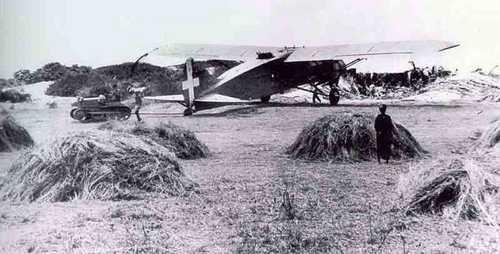
Italian Forces
Few and old airplanes
Stato Maggiore Aeronautica
Lugh Ferrandi airfield, Somalia, Summer 1940, after the Italy’s entry in the war: an obsolescent bomber Caproni Ca.133 (nicknamed “Caprona” by the Italian aviators) of the XXIX Gruppo, 9th Squadriglia, towed by a tracked tractor Fiat OCI 708. Right from the start of the war the Italian East Africa’s defense (the Mussolini’s Empire), a broad territory including Eritrea, Ethiopia and Italian Somalia completely surrounded by hostile forces (and with large insurgency’s forces in Ethiopia), appeared a despaired venture. Despite the Europe’s rush to the war, the Rome’s Government made late a really effort to strengthen with modern weapons the armed forces of the Vice Roy Amedeo di Savoia-Aosta (the Duke of Aosta) before the war’s outbreak. Furthermore because the sea and air routes on territories under British control the supplies transport were difficult, already on March 1940 the British forbidden the Egypt’s overfly, and with the Italy’s entry in the war also the Red Sea routes was immediately stopped. The AOI’s Air Force (AOI for Africa Orientale Italiana/Italian East Africa) suffered especially of this situation. On 1st November 1939, two months after the WW2 outbreak, the AOI’s Air Force were a little force (total inventory 323 aircraft, full serviceable with the operational units 166) mainly equipped with obsolete aircraft as the Caproni Ca.133 (inventory total 183, full serviceable with the bomber units 103) a three engine fixed landing gear colonial bomber which given a good account of oneself during the Abyssinian war on 1935-1936, but completely outdated before an enemy as the RAF. The same for the fighter biplane Fiat CR.32, an aircraft of half Thirties (total inventory on 1st November 1939 36, full serviceable with fighter units 31) overage respect the Gloster Gladiator and completely outclassed by the other British fighter present in the East Africa’s theater, the Hawker Hurricane. Also outdated was the other bomber present inside the AOI’s Air Force, the three engine fixed landing gear Savoia-Marchetti S.81 (inventory total 36, full serviceable with bomber units 16) employed in the Abyssinian and Spanish Civil War, in the Italy already in large amounts replaced by the S.79. The only modern airplanes of the Empire were few bombers Savoia-Marchetti S.79 and Fiat CR.42 biplane fighters, this latter able to fight on equal terms with the Gladiator, but non with the Hurricane. Despite the presence in Eritrea of aeronautical factories for aircrafts and engines maintenance and overhaul, as Caproni and Piaggio, the Air Force suffered the lack of spare parts and many airplanes classified as “on repair” in reality were used as spare parts sources. Scarce also the fuel and the ammunition reserve. In effect on 1939 was planned the strengthening of Italian East Africa’s Air Force with 36 S.79 bomber of the 41st Stormo ferried from the Italy overflying the Egypt plus other 36 transferred by ship and with various materials (engines included), aviation fuel and ammunitions. This planning were possible in part also thanks to the Italy-Great Britain Agreement of 16 April 1936: reciprocal information’s exchange about each armed forces growth and movement inside the African territories. But the events turn and the worsening of the Italian-British relationship allowed only a small part of this program: only 18 S.79 delivered by ferry flight before the interdiction of the airspace over the Egypt, delivery of 36 fighter CR.42 shipped from Naples instead the 36 S.79 planned. Fuel, ammunitions and spare parts was never delivered because the block of the Suez Canal. So the inventory at the date 10 June 1940 were only 107,000 ton of aviation fuel, 5,300 ton of bombs and 8,620,000 shots for machine guns. At the same date, Italy’s declaration of the war to France and Great Britain, the AOI’s aircraft full serviceable were 183: 138 bombers (Ca-133, S.81, S.79), 36 fighters (CR.32 and CR.42) et 9 air observation airplanes (all IMAM-Romeo Ro.37bis) under the Comando Aeronautica Impero (Empire Air Force Command), commander General Pietro Pinna, Addis Ababa, with three Settori (Sectors): North (Asmara), Centre (Addis Ababa), South (Mogadishu). With this weak forces, and the same was for the Army, the Duke Amedeo di Savoia-Aosta, itself an Air Force General, went to face the enemy’s air forces. Victor Sierra
2808 Views
11/17/2012
